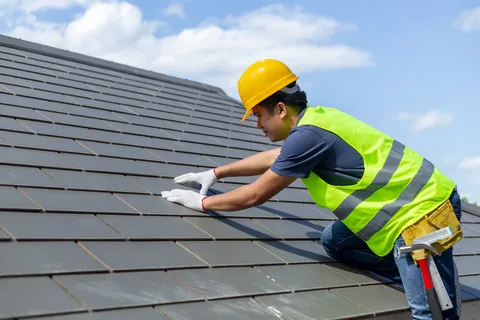
Boston’s ever-changing weather poses unique challenges for homeowners, particularly when it comes to maintaining their roofs. From freezing winters to salt-laden coastal winds, the city’s climate can take a toll on even the most robust roofing systems. In this guide, we’ll explore some of the most common roofing problems Boston residents face and discuss how to protect your home from these weather-related issues.
Contents
The Impact of Boston’s Climate on Roofs
Boston’s climate is characterized by a wide range of weather patterns, including heavy snowfall, ice storms, high winds, and salty coastal air. Each of these factors can cause significant wear and tear on your roof, leading to various problems that, if left unaddressed, can result in costly repairs or even a full roof replacement.
Let’s take a closer look at some of the primary roofing challenges Bostonians encounter due to the city’s unique climate.
1. Snow Load
Boston is notorious for its harsh winters, which bring heavy snowfall that can accumulate quickly on rooftops. The weight of this snow, known as the “snow load,” can put tremendous stress on your roof’s structure. When a roof is not built or maintained to handle this weight, it can sag or, in extreme cases, collapse.
To avoid snow load issues, it’s important to clear snow from your roof regularly during the winter months. Hiring a roofing contractor Boston can ensure the job is done safely and effectively. These professionals can also assess your roof for signs of weakness or sagging, recommending repairs or reinforcements where necessary.
2. Ice Dams
Ice dams are another common roofing issue in Boston. These form when heat escapes from your attic and melts the snow on your roof, causing water to flow down to the eaves where it refreezes. Over time, the ice builds up and forms a dam, which can prevent proper drainage. Water trapped behind the dam can seep under your shingles and cause leaks, leading to serious water damage inside your home.
Preventing ice dams requires proper attic insulation and ventilation to keep your roof cold enough to avoid snowmelt. If you’re already dealing with ice dams, calling a roofer Boston can help mitigate the damage. Roofers can remove the ice and assess any potential water damage before it escalates.
3. Salt Corrosion
Boston’s proximity to the Atlantic Ocean exposes many homes to salty air, particularly in coastal areas. Salt particles carried by the wind can land on your roof, accelerating the corrosion of roofing materials, especially metal. Over time, salt corrosion can weaken your roof, causing leaks or structural issues.
To protect against salt corrosion, regular roof inspections and maintenance are crucial. A roof repair Boston specialist can apply protective coatings to metal roofs or recommend roofing materials better suited to withstand salty environments. This proactive approach can extend the lifespan of your roof and prevent premature deterioration.
4. Wind Damage
Boston experiences strong winds year-round, which can loosen or even rip off shingles, leaving your roof vulnerable to leaks and further damage. High winds can also knock down tree branches, which can land on your roof and cause significant damage to your shingles or underlayment.
Inspecting your roof after major storms is essential to identify any missing or damaged shingles. If you notice signs of wind damage, contacting roofing contractors Boston is the best course of action. Roofers can replace missing shingles, reinforce weakened areas, and help you waterproof your roof against future windstorms.
5. Thermal Expansion and Contraction
Boston’s temperature fluctuations, especially during the transition from winter to spring, can cause your roof materials to expand and contract. This constant movement can lead to cracks, particularly in materials like asphalt shingles. Over time, these cracks can allow moisture to seep into your roof, causing rot or mold growth.
Regular roof inspections are key to catching these cracks before they turn into larger problems. Professional roofers specializing in roofing Boston MA can spot signs of expansion-related damage and repair or replace affected areas.
Tips for Preventing Roofing Problems in Boston
While Boston’s weather is beyond anyone’s control, there are steps you can take to protect your roof from damage and extend its lifespan.
1. Schedule Regular Inspections
Routine roof inspections by a professional are crucial to identifying potential problems early. Aim to have your roof inspected at least once a year, especially after major storms or at the beginning and end of winter.
2. Keep Your Gutters Clear
Clogged gutters can exacerbate ice dams and prevent proper drainage, leading to leaks and water damage. Make sure to clean your gutters regularly, particularly during the fall and winter months.
3. Invest in Quality Materials
When it’s time for roof installation Boston, choose durable, weather-resistant materials that can withstand Boston’s climate. Metal roofs, for example, are ideal for areas prone to snow, while materials like slate are highly resistant to salt corrosion.
4. Work with Local Experts
Boston’s roofing challenges require local knowledge and experience. When you need repairs or a new roof, make sure to hire experienced roofing Boston professionals who understand the specific needs of the region and can offer tailored solutions.
Conclusion
Boston’s weather presents unique challenges for homeowners, particularly when it comes to roofing. From snow loads and ice dams to salt corrosion and wind damage, maintaining your roof requires vigilance and regular care. By working with skilled roofing contractors Boston and staying on top of inspections and maintenance, you can protect your home from the elements and avoid costly repairs down the road.
If you’re unsure about the current state of your roof, now is the perfect time to schedule an inspection and ensure your home is prepared for whatever Boston’s unpredictable weather has in store.








